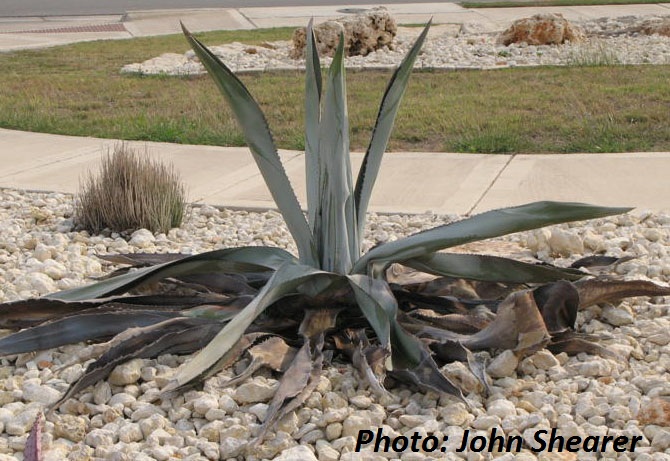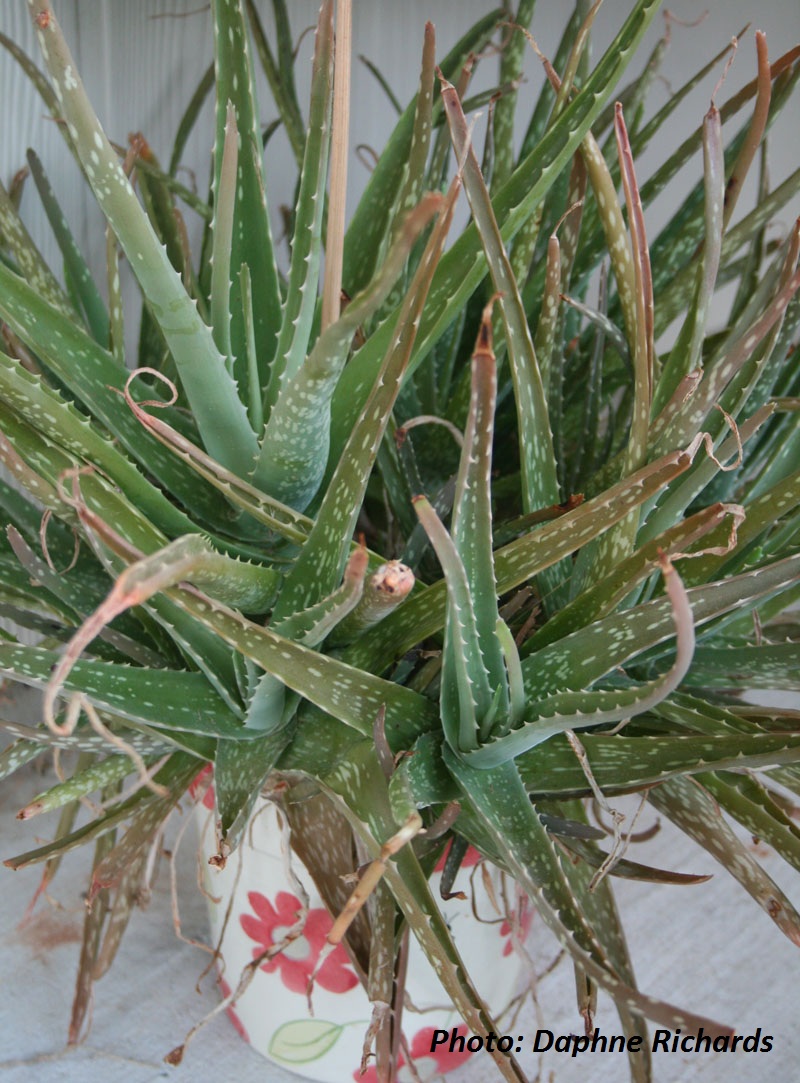July 28, 2011
Succulents pests with Wizzie Brown
Warning! Some of today’s images are scary. Here’s a preview, taken by CTG viewer John Shearer.

So far, I haven’t had any trouble with my agaves and yuccas. In fact, I plan to add a few more. I really like my soft leaf yucca (Yucca recurvifolia), the perfect dynamic in bright shade with a few hours of torturous sun.

I’ve kept my Agave striata in a pot for years, rather than deal with my drainage issues. Supposedly it’s hardy to 15° or even lower. Mine sure did fine last winter. I may add some to the ground, since I dearly love it. It will only get about 2 – 3′ tall. When I bought it from Yucca Do, they said it also did well in dry bright shade as well as full sun. For years, I had it on the patio where it got shade a lot of the day.Last year, I put its pot in the hot spot of the crape bed to see if I liked it there. I do.

I have three gray yuccas in front: this one is Yucca pallida. It gets bright shade with some poignant sun. I just coveted that silvery form, and so far, they’ve all been fine in my heavy soil amended over years with compost.

My only cactus is the Santa Rita prickly pear (Opuntia santa-rita) which returned from the dead after winter’s ” weather event.”

A lot of it was black and mushy, but with other things to attend, I left it. When it started showing signs of renewal, I cut off the icky parts, let the “neutered” pads dry for a week, and replanted.
My spineless prickly pear succumbed to cactus bugs/cactus coreids (Chelinidea sp.).

I got rid of them, but due to their damage, combined with hail and freeze in 2009, I tossed the whole thing into the compost pile. By golly, those little devils took root and now I have a healthy cactus factory amongst the potato peelings and bunny litter.
Cactus bugs are one of the insects Tom investigates this week with Wizzie Brown, Texas AgriLife Extension Service Extension Program Specialist- IPM.

A few years ago, most of us had never seen or heard of them. Then they came marching in to get our attention. Like this cactus bug, (Hesperolabops gelastops), they’re easy to control if you start early and stay on it! Strong blasts of water will do it. Or spray with a soap or horticultural-based product like Neem. But avoid using in hot temperatures!

A few months ago, viewer Linda Avitt wrote in about the Yucca plant bug (Halticotoma valida) on her soft leaf yuccas. Her question prompted this segment with Wizzie!

Like the cactus bugs, this one sucks the plant. Use the same water blast/soap/horticultural oil treatment. She did this morning and evening and got it under total control. Thanks, Linda, for the update!
Another little sucker is Cochineal scale, related to mealybugs.

But many people cultivate this one by diving under its protective cover to squish the insect for red dye.

I actually have a wall hanging woven with plant and cochineal insect dyes!

Wizzie’s got even more, including how to avoid problems, but let’s get down to the really scary one, agave snout weevil. I’m sorry that Philip Leveridge met their acquaintance in East Side Patch, but thanks for the great pictures!

John Shearer kindly took pictures of its wide-spread damage, if you’ve been lucky enough to not see it person.

The female agave snout weevil lays her eggs at the base of a leaf. When the larvae hatch, they bore into the plant, eating out its heart, and providing entry for bacteria, fungi and viruses. The plant soon collapses, never to recover.

Right now, the only control for home-owners is imidacloprid. This is HIGHLY toxic and will kill off everything.
Sorry to be such a pooper here, but it’s true: “Know your enemy.” For more about insects (good and evil) follow Wizzie’s informative and insightful blog for updates on what’s bugging you! I relied on a blog post last year for pesky indoor fruit flies.
On tour, we repeat Jeff Pavlat’s outstanding succulent garden design, home to hundreds of species, with nary an insect problem. If you haven’t seen it before, it’s beautiful inspiration for your own drought-tough designs.

And you can meet Jeff and other members of the Austin Cactus and Succulent Society at their show & sale on September 3 & 4 and get tips from the experts on how to grow them. Don’t be scared off by our scary stuff. These plants have been around a long time!
So have Texas tree lizards, and we thank Robert Breeze for this week’s Garden Pet of the Week: The Dude!

He likes to join Robert every morning to get misted, along with the tomato plants. You know it’s hot and dry when lizards need water! And what a wonderful connection to make, too. Most of our wildlife is extremely beneficial, like The Dude. Robert’s story reminded me of the anoles that follow me around as I water plants. Not only do we want to observe the evil in our gardens, we want to observe, protect, and enjoy the ones that give us delight.
On succulent plants, the question CTG often gets is about aloe vera. It’s an easy plant to grow and very handy when a fire an or “a cooking event” gets you. It’s also easy to kill with too much love. This week, Daphne explains how to keep your garden first-aid in good health!

And get Daphne’s answer on “how and why to pinch a plant?”

John Dromgoole concocts a well-draining soil mix for your succulent plants, and demonstrates how to move a prickly one without needing first-aid attention!

Also, in case you missed last week’s post, Wizzie LOVES the MiteYFine sprayer to get the bugs off your succulents!
Until next week, Linda

